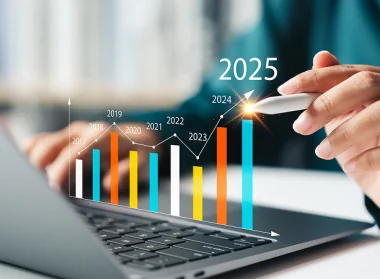Since the pandemic in 2020, supply chain disruptions have become more commonplace. Many procurement departments found themselves fighting against the current reactively and discovered that their internal processes needed work.
For many years, it’s been argued that your company should work toward adopting predictive analytics in procurement, otherwise known as predictive procurement.
The companies that have come out on top as a result of the pandemic chaos are those that made the shift from being reactionary to proactive.
Those that have failed to shift are those currently struggling to survive.
Understanding how and why shortages happen, along with the relationship between supply chain and procurement, and how your organization’s internal procurement processes can be structured and improved to alleviate supply chain disruptions are mission-critical in 2022 and beyond.
Data analysis helps to capture better prices, improve order fulfillment speed and more. With automated processing, you can control spend and improve the bottom line. Predictive analytics ensures you’re ready no matter what scenario becomes reality.
Predictive procurement, also known as predictive sourcing, is more than the latest trend in procurement. It’s how today’s procurement functions can stay relevant and keep their businesses operating smoothly in the face of uncertainty.
Every procurement team tries to stay ahead of the market.
They know how important it is to lock in suppliers at advantageous prices when signs point to big changes in demand or potential disruptions across the supply chain.
The truth is that humans and basic software can’t address all possible variables. That’s where predictive analytics and digital transformation come into play.
What is Predictive Analytics?
According to Investopedia, predictive analytics is “ the use of statistics and modeling techniques to determine future performance based on current and historical data.”
It uses your current and historical data patterns to determine the likelihood of these patterns emerging again in the future.
It allows investors and businesses to adjust their resource usage and allows them to take advantage of possible future events.
It also empowers them to improve operations and reduce risk.
How Predictive Analytics Helps Procurement
In procurement specifically, predictive analytics uses data from your spend management, supplier information, and raw materials data to perform analysis and determine patterns while predicting future trends and outcomes.
The insights you get from this type of analysis can be used to improve supplier management and supplier relationships, find opportunities for cost savings, boost sustainability, and more.
Predictive analytics helps procurement by helping to control expenditures and improving outcomes associated with your spending.
Using predictive analytics makes it possible for procurement teams to identify patterns within the organization and predict a variety of future scenarios.
This way, you know how to respond should one of these predictions become reality. It allows for faster, more accurate decision-making overall. By knowing what potential challenges you could face in the future, you can be ready for nearly anything as it happens.
Let’s take a closer look at three specific ways data analysis can help your procurement department.
Improve Your Spend Analytics Process
In the past, procurement staff has had to deal with multiple databases filled with both structured and unstructured data.
Even the best of the best have to be able to consolidate this information and analyze it in one place.
The insights enable teams to combine expected fluctuations in supply and demand with various real-world environmental factors to create scalable pricing models.
Applying big data analytics allows procurement leaders to combine diverse data sets into a comprehensive analysis.
Based on the analysis, teams can find opportunities to reduce spend and improve the company’s profit margin.
For instance, using spend analytics with a $200 million annual budget, PPG Industries was able to reduce their indirect spend by 95% using central visibility. They also were able to reduce suppliers by 90% And capture a 10% hard dollar savings overall.
With the data analysis, it’s possible for your organization to make the best possible decision by incorporating risk analysis into your decision-making process.
By generating data related to compliance risk, geographical risk, pricing, and preventive measures, your team can better anticipate future issues with the supply chain.
Demand Forecasting Optimization
If your business isn’t prepared for a change in demand, you won’t be able to take advantage of the best possible prices which could strain supplier relationships as they struggle to meet your short-term requirements.
Major increases in demand may be cyclical and happen fairly often.
Companies that ensure stock availability is managed will always be prepared for the spikes (and the plunges.)
However, fluctuations in demand don’t always happen predictably as evidenced by the pandemic.
In addition to the supply chain disruptions, we’ve also seen changes in consumer behavior which forced procurement experts to gain better visibility into mission-critical parts of their supply chains as fast as they possibly could.
Data analytics is useful when it comes to both recurring and unexpected factors to make it easier to accurately forecast demand in a way that benefits the procurement staff as well as the entire business.
Improve Your Supplier Management
Data analytics is also helpful when conducting comprehensive supplier evaluations. It can take into account various elements such as quality of goods and services, cough, and the rate of on-time delivery.
A well-organized analytic system allows vendors to be evaluated and ranked on all relevant aspects of their offerings and compared.
This allows teams to find the most effective supplier solutions whether it be vendor consolidation, or changing open-market transaction-level.
You can also use it to effectively manage contracts, forecast liabilities, and optimize discounts.
How Your Company Can Make the Switch to Predictive Procurement
Edmond Zagorin founded bid Ops in 2017. bid Ops is known as the first company to use artificial intelligence to completely automate supplier negotiations.
Sagarin was frustrated with how much manual data entry was involved and the traditional procurement software needed to fully execute strategic sourcing.
This is where Bid Ops “Five Ps” come into play. They are: People, Process, Predict, Prioritize, and Produce.
People
Bid Ops says that people are often overlooked. People run every organization’s procurement department from the chief procurement officer to the most recent hire on the sourcing team. Many businesses take the people and procurement for granted, which is a mistake.
If one of your business goals is to become a high-performing organization, invest in your talent strategy early.
By investing in training and development for your staff, you can build the foundation you need for success.
Data shows that consultants who have adopted advanced strategies including predictive procurement have an easier time attracting top talent.
Process
If you want your organization to make predictive procurement work, you must be willing to analyzing update your processes.
If you’re using outdated processes such as tracking everything in a spreadsheet, it will be hard for your predictive procurement strategy to remain effective.
It’s crucial to adopt new processes to support your protective procurement initiative because you get the bonus of moving your staff away from manual repetitive tasks to less mundane and more challenging value-added tax.
The process is used are also an important part of attracting the best people to your organization.
The same research suggests that high performers are up to five times more likely to have fully deployed advanced analytics, 10 times more likely to have fully deployed robotic process automation solutions, and have fully deployed predictive analytics capabilities.
They’re also 18 times more likely to have fully deployed AI capabilities.
AI is a key tool for keeping your processes modern and enabling predictive procurement.
Predict
Kait Reis, digital marketing manager for Bid Ops says, “Historically, much of what a procurement organization did has required making cognitive judgments.”
As the amount of data procurement teams produces continues to increase, if you’re looking to predict at scale, you will benefit from using AI. With big data, it’s impossible to rely on human data analysis.
The technology scans massive amounts of data fast and has the ability to grade outcomes for nearly any process or variable.
Outliers can be flagged for human intervention. Anomaly detection and forecasting KPI reports are necessary to enable prediction.
Prioritize
If you don’t take the time to prioritize, it’s difficult to adopt predictive procurement. The issue is that your organization and even your CPO can spend all day focused on transactional busy work.
These tasks, are often repetitive and dull making it easy for errors just show up.
If you want to be successful with predictive procurement, you have to prioritize tasks that are higher in value.
Put your staff on the value-added task and your entire procurement team operates more strategically allowing them to become more involved in the business process.
Machine learning and AI take care of the dull and repetitive stuff for you with automation.
With the help of procurement solutions like PLANERGY, you can feed reliable, accurate data into the analysis to ensure you’re on the right track at all times.
Produce
By combining prediction and prioritization, procurement functions can improve the results.
Your goal is to drive more outcomes that are optimized over time.
With prediction catching and correcting the outliers, and prioritizing everything so that your skilled procurement team can focus our efforts on your high leverage activity see, you always get better outcomes in the long run.
Before you can take advantage of predictive analytics and procurement for your organization, you must first cleanse your data.
If the fundamental data at the base of the entire process is inaccurate, then the outcomes will also be inaccurate.
After you know you have clean and accurate data, you should work on identifying correlations between the drivers and prices.
From there, you need to establish a warning system that highlights any unnecessary price deviation. Finish implementation by generalizing your required forecast methods.
Organizations that take action to implement predictive analytics now will be miles ahead of the competition that fails to move.
While predictive procurement is currently an early trend, it will soon become an industry standard. If your company is prepared, you’ll have a competitive advantage.




